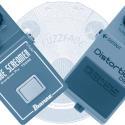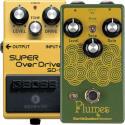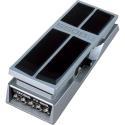What Is Gain On an Amp: A Clear Explanation

Today, I want to tackle the important question of what is gain in an amp. To kick things off, let me tell you there is a clear distinction between distortion and gain.
As an amp function, it is possible to add gain without distorting the signal. And while gain can make your sound louder, it's not the same as volume.
Because of these overlapping functions, some misunderstand what gain really means.
But we're going to clarify this in this article. You'll learn the true meaning of gain and how to make the most of it in your setup.
By learning these concepts about gain adjustment, you'll be able to better utilize your amp parameters, which will improve your overall sound.
But before diving deeper into the topic, let's start by clearing out a common misconception about gain. Let's first clarify the confusion over the terms gain, distortion, and volume.
What's the Difference Between Gain, Distortion, and Volume?
To start, gain is the determining factor in how much an input signal is amplified. It lets you raise or lower input level. It is analogous to the faucet knob, which controls how much water goes in through a hose.
On the other hand, volume refers to the loudness of the output of an amp, limited by the how much power the poweramp section has. You can think of it as a garden hose nozzle, which controls how much water goes out of the hose.
Lastly, distortion is the result of audio clipping due to too much gain applied. As the audio signal is driven hard, parts of the signal are clipped and lost, which results in sonic distortion.
Where the Confusion Lies
The confusion stems from how gain behaves - gain affects volume and distortion. Raising and lowering gain affects volume proportionally. And turning the gain up past its clean headroom limit will create distortion in the signal. This has led some to think that gain is just another volume control.
But as explained above, gain has a specific function, and is used differently from volume and distortion. The similarity is mostly due to how gain impacts volume and distortion levels.
So in order to get a good amp sound, you need to know how gain, volume, and distortion functions. And you also have to be aware of how they interact, specifically how gain interacts with distortion and volume.
Some older guitar amps with just gain and volume can produce distortion by simply raising the gain levels, so gain are sometimes thought of as the distortion control. But there are amps with dedicated distortion knobs let you fine-tune your distortion level, you'll sometimes find this control on a big amp and on a small battery powered guitar amp.
What is Gain on an Amp?
Gain in audio amplification refers to the amount by which a signal is increased when amplified.
For instance, if you pass a signal through an amplifier and it comes out at the output as twice the original, then the gain factor is 2.
If the output gain is the same as the input volume, then the gain factor is 1, AKA "unity gain" (0 dB).
You'll hear this term commonly used when adjusting the faders on a mixer. Setting the gain to unity on a mixer is equivalent to placing the faders at the 0 dB level.
Since gain raises the input signal into a strong signal, it also increases input sensitivity. And this increased sensitivity is foundational to certain styles of guitar playing, including rock and blues.
A Little Piece of History
Back in the 1940s, guitarists were still just starting to explore the capabilities of guitar amplification. Guitar players like Muddy Waters and Junior Bernard were among the first to demonstrate a fuzzy guitar sound quality.
They achieved that sound quality by mainly driving their guitar amp past its limits. Although, compared to today's distortion, these breakups are quite small or thin. However, this generation of guitar players is credited with revolutionizing guitar sound.
Modern high-gain sound synonymous with rock, metal, and similar genres owes its existence to these pioneers. And to this day, it still utilizes the same distortion principle, only cleaner and more controlled.
Why is Gain Important?
Gain's primary function is to amplify the input voltage or signal from instruments like guitars or microphones. It ensures that the signal reaches an optimal level for further processing, to an output voltage or signal, and eventually to projection through speakers.
Beyond amplification, gain is also crucial for achieving an ideal signal-to-noise ratio. It makes the desired signal stand out against background noise or interference. As a result, you'll get a clear and high-quality reproduction of the original signal.
Gain control also provides musicians with dynamic range control. It offers the ability to adjust the softness or loudness of sounds without introducing much distortion.
Moreover, adjusting the gain directly impacts tone, as it influences the characteristics of an instrument's sound.
For example, higher gain settings, particularly in guitar amplifiers, can introduce distortion. This adds a unique edge suitable for genres like rock or metal, while a lower gain setting provides a cleaner tone.
Overall, gain proves to be a versatile feature that significantly influences audio signal quality. It allows for nuanced musical expression as well.
What Are High Gain and Low Gain Preamps?
When talking about amp gain, we're typically referring to preamp gain. A preamp design can determine how much gain an amp can have and what the effect of that gain is on the audio signal.
Low-Gain Preamp Stage: A low-gain preamp stage ensures that the maximum possible gain will not exceed the clean limit of the preamp. This means you'll get a lot of input stage amplification with minimal distortion.
High-Gain Preamp Stage: In contrast, a high-gain preamp is designed so that the clean limit is quickly exceeded as gain is increased. This causes most of the signal gain to result in distortion.
Setting up your amp's gain alters the sound quality of your output. Adjust the gain according to your preference and the capability of your amp's preamp stage.
This is crucial because too much gain will oversaturate your signal, which makes it sound muddy (reduced clarity). Similarly, too little gain will result in lower output, which can make it sound thin, and you may lose the distortion effect that you're going for.
To put it simply, gain affects how clean or dirty your sound will be.
What Are High Gain and Low Gain Amps?
High-gain amplifiers are built using high-gain preamplifiers. These preamps allow the signal to quickly exceed the clean headroom limit.
These amps are noticeable to have more distorted sounds, even at lower volumes. If you increase the gain control, it will only change distortion rather than volume. This leads to a more saturated distortion sound.
High-gain amps frequently feature two channels, one clean and one dirty, and each channel has dedicated preamps that allow for the gain and distortion level variations.
They can include a master volume control in the power amp section as well. This allows you to modify the total volume after setting the gain without causing further distortion.
Examples of High-Gain Amps: Marshall DSL 40, Orange Rush Pro EVH 5150, and Mesa Boogie's Dual Rectifier.
Low-gain amplifiers operate oppositely. These amps are intended to feature low-gain preamps. It has clean headroom limits that are always higher (or at least at the maximum settings) than gain.
This means that even if you crank up the gain on these amps a bit higher and still hear an increase in volume, rather than a big increase in distortion.
This amps can produce great, clean tones at high volumes. And with more power via volume, they produce a gritty type of distortion that many experienced guitarists prefer.
Note that low-gain amps can be cranked hard to produce high-gain tones. But since the amps are driven hard, the resulting tone is gritty, unlike the smooth, distorted tones you can get from high-gain amps. Blues rock guitarists often employ a gain setup with two stages, the first stage being an overdrive (tube screamer) type pedal, which is used to drive the amp, which serves as the second stage gain.
Examples of Low-Gain Amps: Fender Super-Sonic and Vox AC10,
How Does Gain Work?
An amp's gain has a certain amount of headroom. Increasing the gain within the confines of that headroom will result in a louder signal, but it will not add any distortion.
As you increase the gain, you'll eventually reach the maximum headroom limit of the amplifier. Going over that threshold is what distorts your signal.
The modification of the waveform squashes down the top and bottom ends. This is because it's amplified beyond the clean headroom limit of the amplifier.
And even if you continue to increase the gain factor after that, the overall amplitude of the wave will still stay the same. Instead, you'll just make the signal more distorted and saturated.
You can control the level of gain on your amp with a gain knob; at times, it's labeled "drive." Turning it clockwise increases the gain, while the opposite decreases it.
Common Applications of Gain Control
-
Microphone Gain: In live sound, adjusting the gain on your microphone preamp is important. It helps the sound engineer optimize the level of your microphone's signal. This results in a clear audio input to the sound system.
-
Guitar Amps: Guitarists use gain controls on amplifiers to shape their tone. Higher gain settings add distortion, creating a gritty sound suitable for playing rock, metal, and similar genres. Lower gain settings result in cleaner tones, which is great for blues, classic rock, funk, and the like.
Bassists use gain controls similarly to achieve specific distortion levels. They also generally maintain a clean tone, depending on the musical style.
-
Audio Interface: When doing home recording, adjusting gain ensures optimal input signals from your microphones or instruments. Proper gain staging on the mixing console is vital to avoid noise and distortion.
-
PA System: In venues with PA systems, gain adjustments are made to microphones and audio sources to match the space's size and acoustics. This ensures an even and clear distribution of the amplified sound.
How To Set Gain On My Amp?
-
Start with a Clean Slate: Unplug pedals and other effects, and set the EQ knobs (bass, mid, and treble) to middle or neutral. This ensures that you get a pure, un-EQ'ed signal.
-
Set a Low Volume: Lower your gain and volume so you don't get surprised by sudden loud sounds. Set it to a volume that's comfortable and easy to listen to, this is especially important if you have an amp with a small speaker.
-
Play your Guitar: Play your instrument as you would during a performance. This will give you a realistic idea of how you'll sound after setting the gain.
-
Gradually Increase Gain: Slowly raise the gain while you're playing until you like the distortion you are hearing. If you have a looper pedal, run a loop of your music while adjusting the knobs. Loopers also allows you to walk across the venue so you can hear the test tone in different locations.
-
Find Your Sweet Spot: Listen carefully to the quality of the distortion. Low-level gain adds a bit of grit to the sound while still retaining much of the clarity of a clean tone. The mid-level gain will give you moderate distortion, also called crunch. Raising the gain further will get you to high-gain territory. Depending on the amp, this will give you highly saturated distorted tones. Ensure that individual notes remain clear and distinct as you add gain. If the sound becomes muddy, you may have too much gain. Note that some amps have dedicated distortion knobs that lets you set the distortion level more accurately.
-
Adjust Your Tone: After finding your preferred distortion level, it's time to shape your tone. Add more character to your tone through the EQ controls. Most low-gain settings are paired with mid-focused EQ. While crunch and high-gain tones are usually EQ'ed to a V shape, where the bass and treble are emphasized. I recommend starting with a flat EQ and gradually raise frequencies to find what works best for your style of music.
-
Raise the Volume: Finally, raise your volume to the level you need for performance and recording.
Final Thoughts
Knowing the answer to the question what is gain on an amp is crucial to getting the best sound out of an amp.
Knowing what gain is and how it interacts with volume and distortion, will allow you to better utilize the controls of your amp to get great sounding tones. And this same principle applies to mic preamps, mixers, and other instrument amps.
When used correctly, gain will give you enough volume without compromising clarity and definition.
And on guitar amps, you'll know how to get different levels of distortion without muddying your tone.
What is your favorite gain setting? Share it with us in the comments.
Frequently Asked Questions
Do All Amplifiers Have Gain Control?
No, not all amplifiers have a gain control. Some amplifiers, especially basic models, may only have a volume knob in them
Can Gain Introduce Distortion?
Yes, increasing the gain past the clean headroom limit of your amp will introduce distortion to the signal. Other players do this deliberately, especially on tube amps, as they sound better when pushed to their limits.
However, you must be careful when dealing with low-gain amps, as they are not meant to be driven hard. Don't overdo your gain level, excessive clipping can damage the speaker of your amp, along with the power supply, or even blow a fuse.
What is Gain Staging?
Throughout the signal chain, your input signal travels a signal path from input to output. Each piece of audio equipment, including pedals, processors, and multiple amplifiers, that the signal passes through is called a stage.
Gain staging refers to the process of optimizing the audio signal before passing it to the second stage, and the next stage. A properly optimized gain structure will allow the signal to pass through without degrading its quality.
What Does a Clean Headroom Mean?
This comes from an automotive term that means the distance from your head to the roof of your car. In music, clean headroom refers to the maximum level at which you can turn your amp gain or volume before it starts to distort or clip.
Contributors:
- Jerome Arcon - Co-writer
- Jerry Borillo - Illustrator












